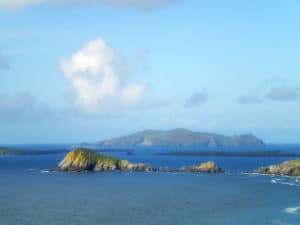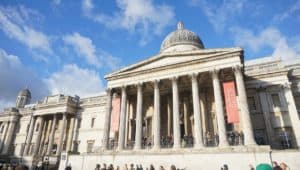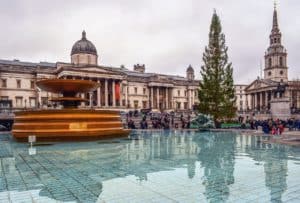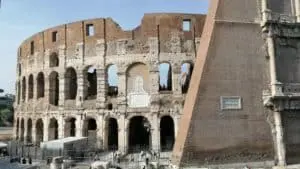Irish Folklore Tales from County Kerry: A Journey into Celtic Mythology

Updated On: April 24, 2024 by Panseih Gharib
County Kerry, nestled in the south-west of Ireland, is steeped in the wealth of Irish folklore tales. Each tale and legend passed down through generations forms the tapestry of a region rich in mythological heritage. Kerry’s folklore is a fascinating blend of otherworldly beings, epic journeys, and enchanted landscapes. As we explore the folklore of this picturesque region, we uncover a world where myth and history intertwine and where the legends continue to resonate with the people of Kerry today.
Our journey through Kerry’s folklore introduces us to a realm where legendary figures like Oisín and the land of Tír na nÓg capture the imagination, showing the depth and breadth of these stories. These tales have been preserved through a robust storytelling tradition that continues to play a vital role in Kerry’s cultural life. Folk practices, supernatural beliefs, and seasonal celebrations rooted in ancient ways also contribute to the county’s rich tapestry of folklore.
Origins of Irish Folklore Tales
In delving into the origins of Kerry folklore, we uncover a tapestry woven with threads of ancient Celtic traditions and later Christian influences, each interlacing to form the rich fabric of Irish culture unique to County Kerry.
Celtic Influences
Celtic Mythology: Tales steeped in Celtic mythology are central to Kerry’s folklore. This ancient system of beliefs and stories provided a lens through which the Celts viewed their world, interpreting natural phenomena and human qualities through a pantheon of deities and mythical beings. The Celts believed in the interconnectedness of all life, an ethos permeating Kerry’s folklore that is celebrated in its narratives and still recounted today.
Festivals: The Celtic calendar was punctuated by seasonal festivals such as Samhain, Imbolc, Bealtaine, and Lughnasa, each marking significant times of the year for pastoral and agricultural activities. These festivals are often found at the heart of Kerry’s folklore, blending the spiritual with the practical aspects of daily life.
Christian Integration
Syncretism: With the advent of Christianity in Ireland, a fusion occurred between the pre-Christian Celtic belief system and the new Christian faith. This syncretism saw the reimagining of several Celtic gods and heroes into Christian saints and historical figures, thereby preserving them within the oral tradition of Kerry’s communities.
Saints and Miracles: Christian narratives, infused with Irish sensibilities, gave rise to local tales of saints and their miracles, which became interwoven with the landscape of Kerry. Holy wells, saintly visitations, and miraculous cures are among the Christian elements that are now integral to the folklore of the region, illustrating the seamless melding of the sacred and the profane.
By examining the Celtic and Christian layers of Kerry’s folklore, we gain an understanding of how these narratives have evolved to form a vital part of the region’s cultural identity. The preservation and celebration of these traditions reflect a reverence for the past and a continuing tradition that shapes today’s storytelling.
Legendary Figures of County Kerry

In the verdant landscapes of County Kerry, tales of heroes, gods, and warriors from ancient Irish folklore resonate through time, weaving a rich tapestry of myth and legend.
Fionn mac Cumhaill and the Fianna
Fionn mac Cumhaill, often called Finn McCool, is renowned in Irish mythology as the cunning leader of the Fianna, a band of noble warriors. Oral traditions and historical texts tell a tale of his bravery and strategic prowess that culminated in many adventures and battles across Ireland. The Fianna are central to Kerry’s lore, embodying the ethos of chivalry and valour that characterised this legendary group.
Cú Chulainn, the Hound of Ulster
Although primarily associated with the province of Ulster, the figure of Cú Chulainn has left its mark in the mythologies narrated in Kerry. Known as the ‘Hound of Ulster,’ this warrior’s exceptional exploits, superhuman abilities, and tragic destiny are recounted with reverence in the stories that have traversed generations.
The Morrigan and Other Gods
The Morrigan, a deity of battle and sovereignty, looms large over the pre-Christian pantheon acknowledged in Kerry. She symbolises the intertwining themes of life, death, and fate within the Celtic cosmology. Alongside her, the pantheon of the Tuatha Dé Danann shines, with gods and goddesses each playing their intricate roles in the epic narratives of Irish myth.
Faery Folk and Otherworldly Creatures

In County Kerry, glimpses into the mystical realm pervade the local folklore, where the lines between our world and the magical blur. We find tales rich with faery beings and otherworldly creatures integral to the cultural tapestry that’s woven through the ages.
Leprechauns and Banshees
‘Irish Gothic: Fairy Stories from Ireland’s 32 Counties’ reports on how the leprechaun, a mischievous yet solitary fairy traditionally clothed in green, is said to hide his pot of gold at the end of a rainbow. Visitors are often regaled with stories aiming to reveal the hiding places of these cunning little creatures famed across Kerry.
Conversely, the banshee’s wail is an ominous herald of death, deeply rooted in Irish lore. ’31 Irish Mythological Creatures describes her mournful cry, believed by many to foretell the passing of a family member. Her presence is woven deeply into the narratives of the Emerald Isle, as attested throughout Kerry.
Tír na nÓg: The Land of Youth
Tír na nÓg, an ethereal place found in Irish mythology, encapsulates the concept of an untouched, immortal realm as mentioned in the ‘Irish Myth, Legend & Folklore Series – Wilderness Ireland’. This legendary land promises eternal youth and beauty, an alluring escape from the mortal world that has ensnared many a heart in Kerry’s folk tales.
The Puca and Other Shapeshifters
Shapeshifters hold a particular fascination within Kerry folklore, with the Puca being among the most enigmatic. This capricious entity, ‘Irish Mythological Creatures: An A-Z guide’, can assume various forms, often animalistic, and interacts with mortals in unpredictable ways. Whether as a harbinger of good fortune or a portent of doom, the Puca’s role in local tales underscores the fluid nature of Irish mythology.
The Mythology of the Landscape

County Kerry’s landscape carries the weight of a rich mythological history intertwined with its natural features and medieval structures. The lore of Lough Leane and legendary tales of ancient castles serve as fascinating portals into a mystical past.
Lough Leane and Its Legends
Lough Leane, the largest of the Killarney lakes, is steeped in fable and reflects a storied history that weaves into the fabric of its surrounding vista. Legends tell of an enchanted island where an otherworldly monastery lies hidden under a veil of magic, invisible to the eyes of mortals. Here, O’Donoghue Ross, a chieftain blessed by the gods, is said to emerge on 1 May every seven years, riding a majestic white horse across the lake’s serene waters.
Notable Myths and Legends

Irish folklore tales are a tapestry woven with many threads of myth and legend, each as colourful and compelling as the next. In County Kerry, some tales stand out for their enduring legacy and the mark they’ve left on the world’s imagination.
The Children of Lir
The sorrowful tale of the Children of Lir is one of transformation and endurance. The story unfolds with Lir’s children being turned into swans by their jealous stepmother, condemned to live as birds for 900 years. This powerful narrative has resounded through generations, encapsulating themes of loyalty, suffering, and redemption. Their presence is felt throughout the landscape of Kerry, echoing the region’s deep connection to the mystical.
Oisín’s Journey to Tír na nÓg
Another cornerstone of Kerry’s folklore fabric is the story of Oisín’s Journey to Tír na nÓg. Oisín, a legendary poet and warrior, was bewitched by the beauty of a fairy named Niamh and taken to the enchanted land of Tír na nÓg – a place where time stands still and nobody grows old. Their tale is not only one of adventure but also one of reflection on the themes of love, youth, and the fleeting nature of happiness.
The Battle of Clontarf
Although not set in Kerry, the Battle of Clontarf resonates throughout Irish lore and its rich storytelling tradition. This epic battle fought on Good Friday in 1014, was not just a clash of men but of mythic forces, with faeries and spectral figures said to be seen amidst the fray. It’s a narrative that epitomises the struggle for power and the very essence of courage – qualities deeply ingrained in the spirit of Irish history and lore.
In weaving these tales, we honour the eloquence of our ancestors and the lands that inspired such illustrious narratives, inviting you to explore the enchanting realm of Irish folklore.
Folk Tales and Storytelling Traditions
County Kerry, with its rich tapestry of history and mythology, is a bastion of Irish folklore tales. Oral traditions thrive here, connecting us to the ancient customs and beliefs that have been woven into the nation’s identity.
The Irish Seanachai
In Kerry, the Seanachai or traditional Irish storyteller, has been a custodian of folklore and history, passing down tales from generation to generation. This revered figure is pivotal in preserving the culture through enthralling narratives that span from fabled warriors to local myths, such as the legend of Muckie the Muckross Monster. These storytellers are master orators, using a rich language that captivates and brings stories to life.
May Day Celebrations
May Day, a festival with pagan origins, is particularly significant in Kerry. Commencing on 1 May, it marks the beginning of summer, celebrating fertility and bounty. Local customs include the creation of the May Bush, a decorated thorn bush, and placing flowers on doorsteps to ward off misfortune. These traditions are part of a larger storytelling fabric, where each custom and symbol carries a narrative stretching back through the ages.
Cultural Life and Folk Practices

In County Kerry, our cultural life pulsates with the rhythm of traditional music and the cheer of folk games, embodying the essence of Irish culture and its historic pastimes.
Traditional Irish Music and Dance
We find a poignant representation of the county’s soul in Kerry’s traditional Irish music. Evenings here are often filled with the sound of the fiddle and the bodhrán, as tunes both jubilant and melancholic emanate from the cosy pubs. Ceilidhs, gatherings filled with music and dance, are the fabric of our social tapestry. The Set dance, a group activity, still thrives, featuring quadrilles and figures influenced by historic French and English dances, adapted into a distinctly Irish form.
Sport and Folk Games
Sport is at the heart of our community, knitting us together through shared passion and friendly rivalry. Gaelic football and hurling are particularly venerated, showcasing a combination of athleticism, skill, and local pride. These games, intrinsic to Irish culture, are not mere pastimes but a way of life, with clubs and societies dedicated to preserving and promoting these ancient sports. Every kick and strike in a match is a reenactment of our folk heritage, a living testament to our ancestors’ playful spirit.
Supernatural Tales and Beliefs

County Kerry, with its rich tapestry of history and legend, is a wellspring of supernatural tales. We delve into a couple of the most intriguing aspects of this heritage—the worship of Anu and the protective role of iron in fairy lore.
Anu, the Mother Goddess
Anu, known as the Mother Goddess, is revered as one of the most ancient deities in Irish mythology. She is often associated with the land itself, personifying fertility, strength, and the earth’s prosperity. In Kerry, Anu is reflected in the landscape—her presence in the Paps of Anu, twin hills said to echo her breasts, highlights the deep connection between the supernatural and the physical world in Irish folklore.
Iron’s Role in Fairy Lore
In the supernatural beliefs of County Kerry, iron has always held a unique significance, especially when warding off fairies. It is rooted in the conviction that fairies have an aversion to iron, making it a powerful protective force. Hanging an iron horseshoe over one’s door was a common practice, believed to keep these capricious beings at bay and to ensure the safety of the home from any fairy mischief.
Our cultural narratives are embellished with such entities as fairies, hinting at an otherworldly dimension parallel to our own. These traditions encapsulate not only a respect for the enigmatic forces of nature but also the wisdom of our ancestors, who crafted such tales to explain and order the world around them.
Festival and Seasonal Folklore
In County Kerry, the intertwining of Celtic traditions with Christian beliefs, as reflected in festivals and seasonal celebrations, brings to life myths and legends that have been passed down through generations.
Samhain and Halloween Traditions
Samhain marks the end of the harvest season and the beginning of winter. This ancient Celtic festival is considered the precursor to modern Halloween and is characterised by activities steeped in Irish folklore. On this night, it was believed that the veil between worlds was thinnest, allowing spirits and fairies to cross over. Masks and costumes were worn to ward off any malevolent entities, and homes were safeguarded with carved turnips, the predecessors to today’s Halloween pumpkins. Traditional feasts included barmbrack, a sweet bread often containing hidden tokens forecasting the eater’s future.
St. Brigid’s Day and Imbolc
Imbolc signifies the start of spring and is traditionally celebrated on 1 February. This festival is linked to St. Brigid, a patron saint of Ireland, who synthesized Christian and Celtic beliefs. Our celebrations include the crafting of St. Brigid’s cross from rushes or straw, which are hung in homes for protection. It is also customary for us to visit holy wells, where we participate in rituals to honour St. Brigid, reflecting the importance of water in both pagan and Christian denominations. The cross and the well visits embody the fusion of ancient Celtic practices with the Christian faith, highlighting our reverence for nature and spirituality.
Influence of Folklore on Modern Culture

Irish folklore, particularly from Co. Kerry, weaves a vibrant tapestry of myths and legends that continues to influence modern culture, from contemporary storytelling to tourism. These tales offer more than just entertainment; they are a testament to Ireland’s heritage and continue to shape experiences today.
Contemporary Storytelling
We acknowledge the everlasting impact that Irish folklore has on the narrative arts. In Co. Kerry, as well as broader Irish culture, storytelling isn’t just a pastime; it’s an integral part of our social fabric. The tradition of seanchaí — the Irish storyteller — persists, transforming tales of old into modern mediums. The myths and legends embedded in Irish folklore preserve not only the magic of the past but also serve as a wellspring for contemporary literature, film, and theatre. These stories maintain their vitality by connecting new generations with a deep-rooted sense of cultural identity.
Tourism and Folklore Attractions
The mystical allure of Irish folklore substantially bolsters tourism in Co. Kerry and beyond. The region’s enchanting landscape, rich with historical sites, offers an immersive experience for those seeking to explore the tangible aspects of our legends. Popular folklore attractions connect visitors to the unseen world of faeries and folklore heroes. As a result, tourism in Ireland flourishes, with travellers embarking on trips to ancient ruins, sacred wells, and fairy forts, each site steeped in story and often accompanied by local guides versed in tale and tradition. These unique cultural encounters underpin the significance of mythology in contemporary Irish life and emphasise the importance of preserving these sites to perpetuate our captivating folklore.
Folklore in Literature and the Arts

The realm of folklore in County Kerry has profoundly influenced both Irish and international authors and persists in enriching the visual and performing arts. Our stories are not only whispered through the winds of the rolling hills but also resonate in the stanzas of songs and lines of literature, echoing through the strings of harps and embraced in our collective prayers.
Influence on Irish and International Authors
In Kerry, folklore has left its indelible mark on literature, nurturing the talents of storytellers who have captured the essence of our culture. Our myths have been artfully woven into narratives that traverse the boundary of time and place. International authors have also succumbed to the allure of Kerry’s legends, incorporating them into works that celebrate the depth of Irish folklore and its place in a global context. These tales often manifest themes of caution and enchantment, drawing readers into a world where the physical and mystical lines merge.
Visual and Performing Arts
The visual and performing arts serve as vibrant canvases for our folklore, with the harp’s melancholic twang often accompanying tales of the fairy folk and ancient heroes. Paintings and sculptures celebrate these narratives, while dancers and actors bring them to life on stage, finding new ways to explore our heritage. Our prayers, embedded with folklore’s wisdom, are melodically matched with song, ensuring that the art forms we cherish carry forth the heartbeat of our culture to future generations.
Frequently Asked Questions

In this section, we’ll explore enchanting folktales and significant symbols that have shaped the rich tapestry of County Kerry’s folklore.
What are the most renowned folktales originating from County Kerry?
County Kerry boasts a wealth of folktales, with the legend of Oisín and Tír na nÓg standing out as an emblematic story. This tale transcends time, depicting a mystical land of eternal youth and beauty.
Can you describe some notable legends from the Killarney region?
Killarney is shrouded in legends, such as the tales surrounding Ross Castle. Stories of ancient O’Donoghue chieftains enrich the region’s folklore, each one intertwined with the lush landscapes and tranquil lakes of Killarney.
Which symbols and emblems are significant in Kerry folklore?
In Kerry’s folklore, symbols like the harp and the shamrock hold profound meaning, representing the region’s spiritual depth and its bonds with the natural world.
What mythical creatures are prominent in Dingle’s folkloric stories?
Dingle’s folklore is animated by mythical creatures such as the púca, a shape-shifting being that encapsulates the whimsy and unpredictable spirit of Irish myth.
How does Irish mythology influence the folklore of County Kerry?
Irish mythology deeply influences Kerry’s folklore, with legendary figures like the Fianna and mythical events like the Cattle Raid of Cooley echoing through its oral traditions and cultural narratives.
What is the significance of County Kerry within Irish storytelling traditions?
County Kerry occupies a central place in Irish storytelling traditions. It serves as a storied landscape where generations have passed down tales celebrating the region’s history, battles, and natural wonders.






